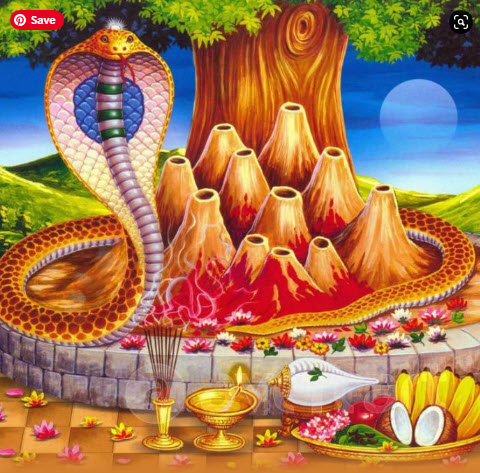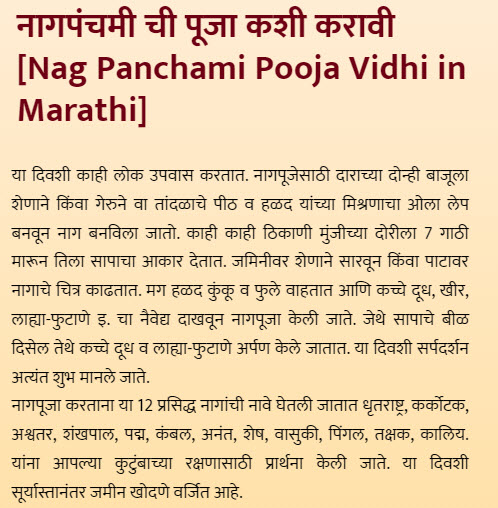

Nag Panchami Puja Vidhi in Marathi: A Celebration of Serpentine Spirits
Namaste, seekers of spiritual connection and enthusiasts of tradition! Today, we immerse ourselves in the rich cultural tapestry of Nag Panchami—a day dedicated to honoring serpentine beings. Join me as we uncover the step-by-step process of the Nag Panchami puja, where devotion and ritual converge. Picture a time when communities gathered to celebrate, and let’s embark on this exploration of reverence and unity.
Chapter I: Fasting and Preparation
Our journey commences with a day of fasting—where devotees abstain from consumption. Imagine this as a moment of spiritual preparation, a way to cleanse both body and mind. The gathering of materials, such as dar or geru (red ochre) and turmeric, signifies the intention to create an offering worthy of serpentine spirits.
Chapter II: Crafting the Serpent
As our tale unfolds, we find ourselves creating a visual representation of the serpent—a symbolic bridge between the earthly and spiritual realms. The mixture of dar or geru, turmeric, and other elements forms a paste, which is then used to craft an image of the snake. The act of molding is like shaping a connection with the serpentine energy.
Chapter III: Invocation and Offering
With grace, the act of invocation begins. Imagine the serenity of the moment, as devotees thread seven knots onto a sacred thread, invoking the energy of the snake. This thread, symbolizing protection, is then either tied around the wrist or worn as a talisman. The earth is revered by creating an image of a snake on the ground with dar or geru, or by drawing the snake’s image on a leaf.
Chapter IV: Reverence and Connection
Now, picture the act of offering—a gesture of gratitude and connection with the divine. Imagine the aroma of turmeric, kumkum (vermilion), and flowers wafting through the air. These elements, along with raw milk, kheer (a sweet dish), and lahya-footane (a mixture of various ingredients), are presented as offerings during the puja. This offering is like extending an invitation to the serpentine spirits, inviting them to join in the celebration.
Chapter V: Legacy of Serpent Guardians
As our story progresses, we learn about the 12 prominent serpents honored during Nag Panchami: Dhritarashtra, Karkotak, Ashwatar, Shankhapal, Padma, Kambal, Anant, Shesha, Vasuki, Pingala, Takshaka, and Kaliya. These names are invoked for the protection of family and home. Picture this legacy as a connection across generations—a legacy of reverence and guardianship.
Epilogue: Celebrating Unity
As we conclude our exploration, let’s remember that Nag Panchami is a celebration of unity—unity between humans and the spirits of nature. While the rituals may vary, the intention of connection remains steadfast. It’s like revisiting an ancient melody—a melody that carries the echoes of devotion and unity through time.
To you, seekers of spiritual connection and advocates of tradition, may you find solace in the embrace of spiritual practices. With each celebration of Nag Panchami, may you honor the serpentine spirits and feel the unity between humans and the divine. Here’s to the legacy of reverence and to the enduring bond between humans and the ethereal energies of the universe.
नागांची पूजा का केली जाते ?
नागांविषयी सर्वसामान्य समज असा आहे की हा एक खूप भयंकर जीव आहे, जो पाहताक्षणीच मनुष्याला दंश करतो. परंतु ही धारणा खरी नाही. सापांच्या खूपच कमी जाती विषारी असतात आणि विषारी सापही बहुधा तेव्हाच दंश करतात जेव्हा त्यांना छेडले जाते किंवा ते पायाखाली दाबले जातात. जंगलात, शेतात माणूस जर खाली पाहून चालत असेल तर सापाने त्याला दंश करण्याचे काही कारणच नाही. या संभ्रमित धारणांचा आपल्या मनावर असा वाईट परिणाम झाला आहे की आपण सापाला माणसाचा जन्मजात शत्रू समजले आहे व त्याला पाहताच मनात भीतीचा संचार होतो आणि मग लगेच त्याला मारण्यासाठी आपल्याकडे काठी वगैरे आहे की नाही याकडे लक्ष जाते. आपल्या मनात त्याला मारण्याची भावना जागृत होताच आपल्या श्वासोच्छ्वासांद्वारे हीच भावना त्याच्या हृदयातही उत्पन्न होते. परिणामी आपली दुर्भावनाच त्याला हिंसक बनविते.
नागपूजेद्वारे सापांप्रती बनलेल्या या दुर्भावनेचे व भ्रांतीचे निराकरण केले जाते. या दिवशी नागांना दूध, सुगंधी फुले वाहून श्रद्धा-भक्तीने त्यांची देवतेच्या रूपात पूजा केली जाते. स्तुतीच्या रूपात त्यांच्या गुणांचे वर्णन ऐकून आपल्या हृदयात त्यांच्याप्रती असलेली दुर्भावना क्षीण होते, ज्यामुळे आपण त्यांना शत्रू नव्हे तर ईश्वरीय सृष्टीचा आपल्यासारखाच एक जीव समजू लागतो. तेव्हा आपल्या मनाची ती अधीरता आणि भीती, जी त्याला पाहताच जागृत व्हायची, ती पूर्णतः शांत होते. लोकांच्या मनातील त्या भितीच्या भावनेचे निराकरण आणि सद्भावनेची जागृती हाच नागपंचमीचा उद्देश असू शकतो. भितीमुळे आपल्या शरीरात हानिकारक द्रव्ये बनतात आणि सद्भावनेने हितकारक भगवद्प्रसादजा मती देणारी रसायने बनतात. नागांच्या पूजेत किती उदार दृष्टिकोण दडलेला आहे ! किती अद्भुत मनोविज्ञान आहे !
नागपंचमीच्या दिवशी काय करावे?
नागपंचमीचे महत्व काय?
नागपंचमी किती तारखेला आहे?